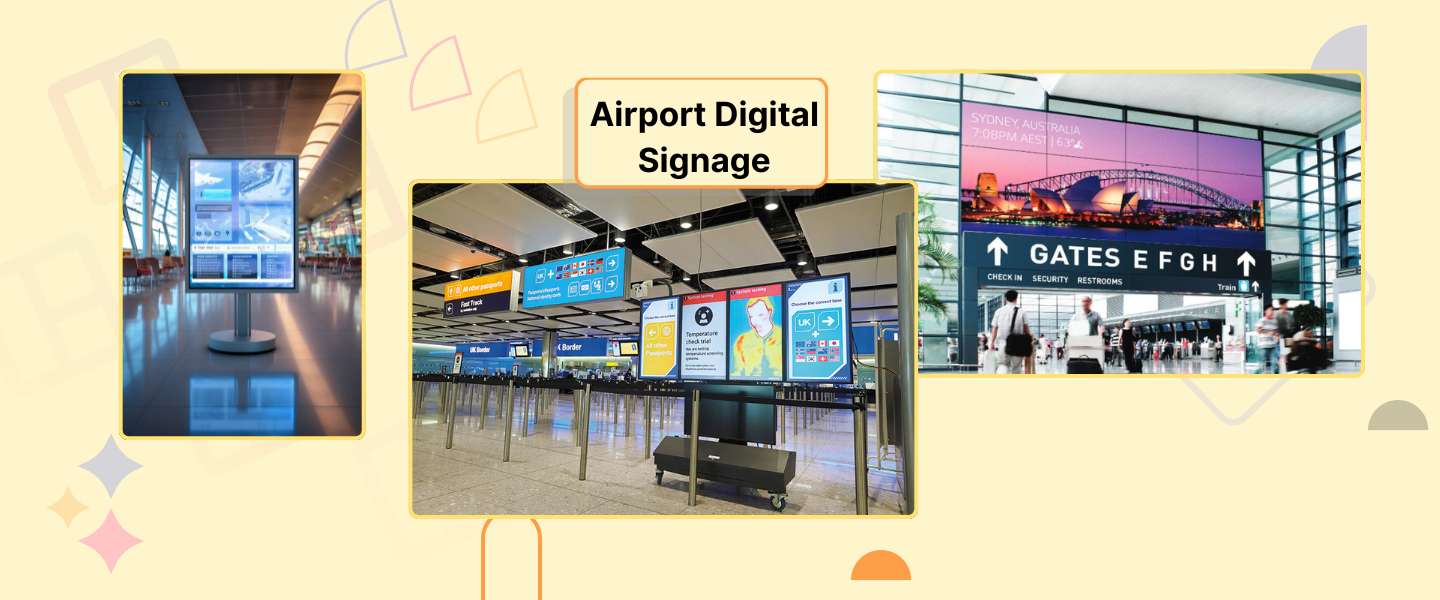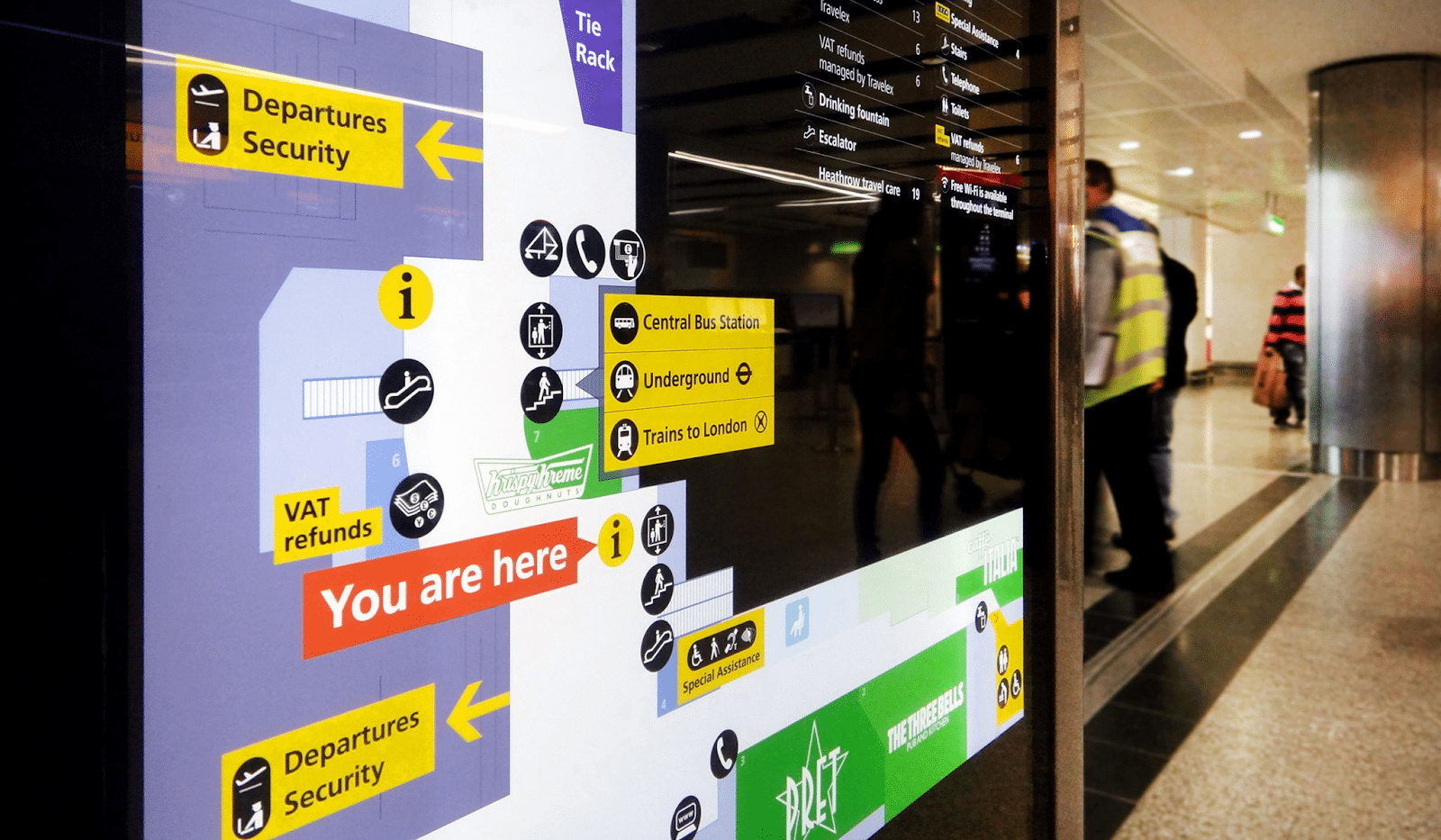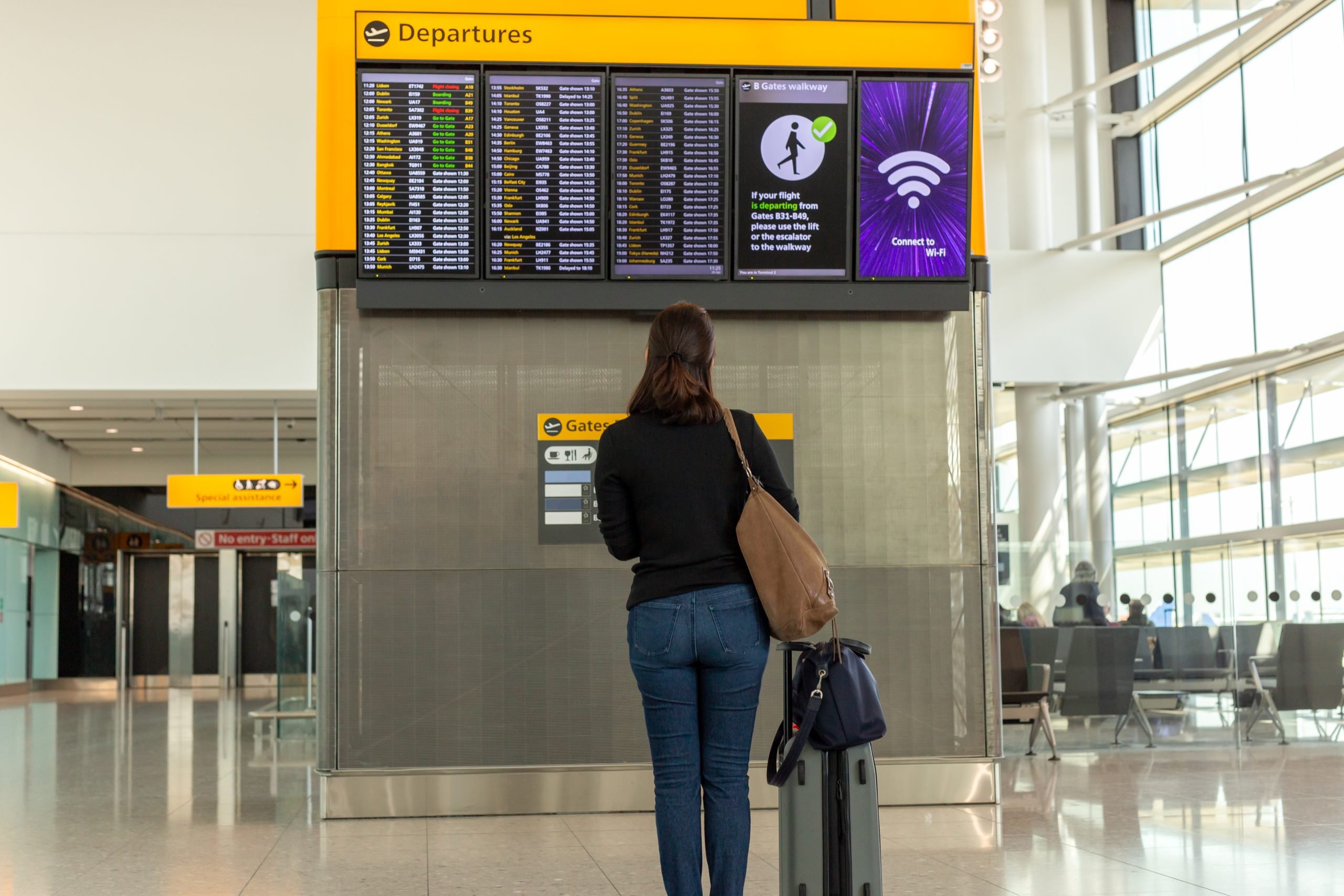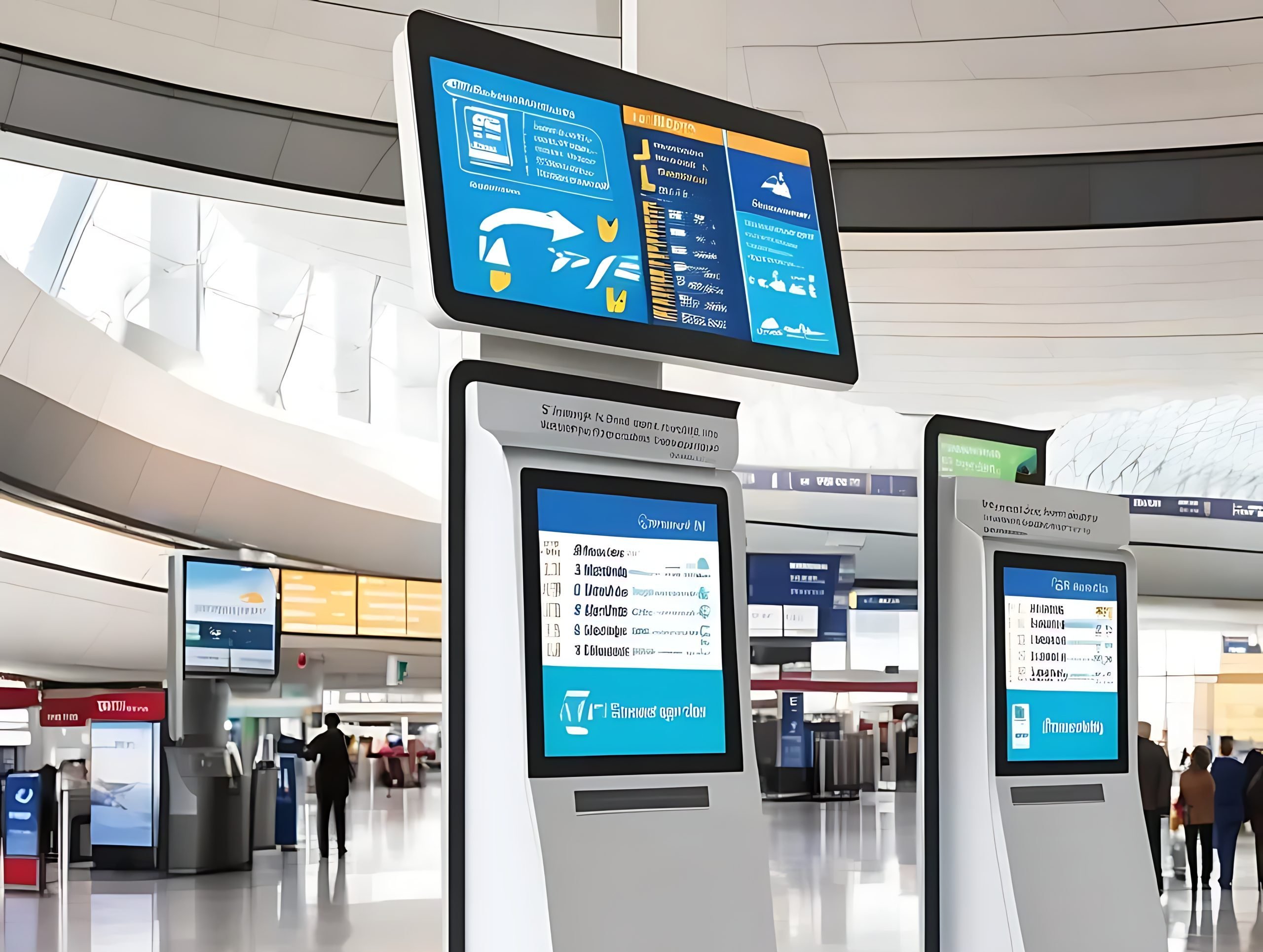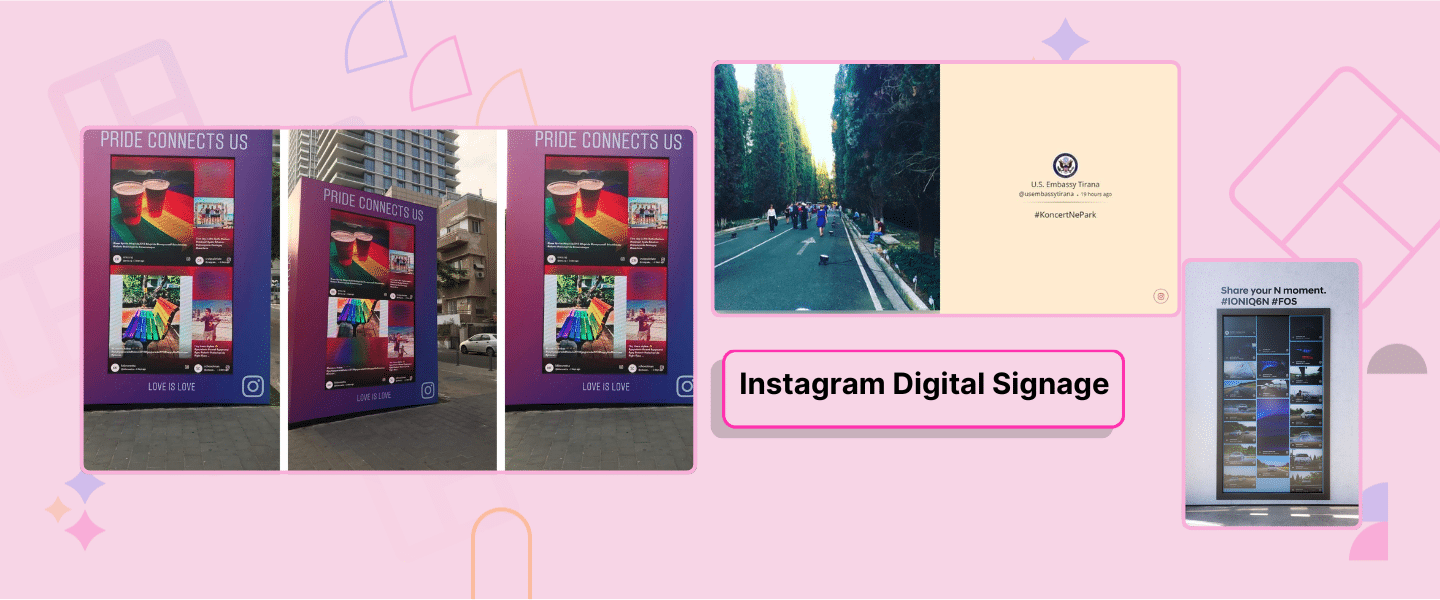Airport Digital Signage: Transforming Aviation and Revolutionizing Passenger Experience
Author: Rohan Singh
8 minute read
Airports can feel like a whirlwind—last-minute gate changes, confusing signs, and the constant race against time. Digital signage in airports steps in like a calm guide, offering real-time flight information, clear directions, and smooth communication. With global air travel projected to reach 8.2 billion passengers annually by 2037, airport digital displays are no longer optional.. This blog explores how these systems, including innovative features like social media walls, address operational challenges and enhance the passenger experience, making it far more pleasant.
Challenges and Solutions
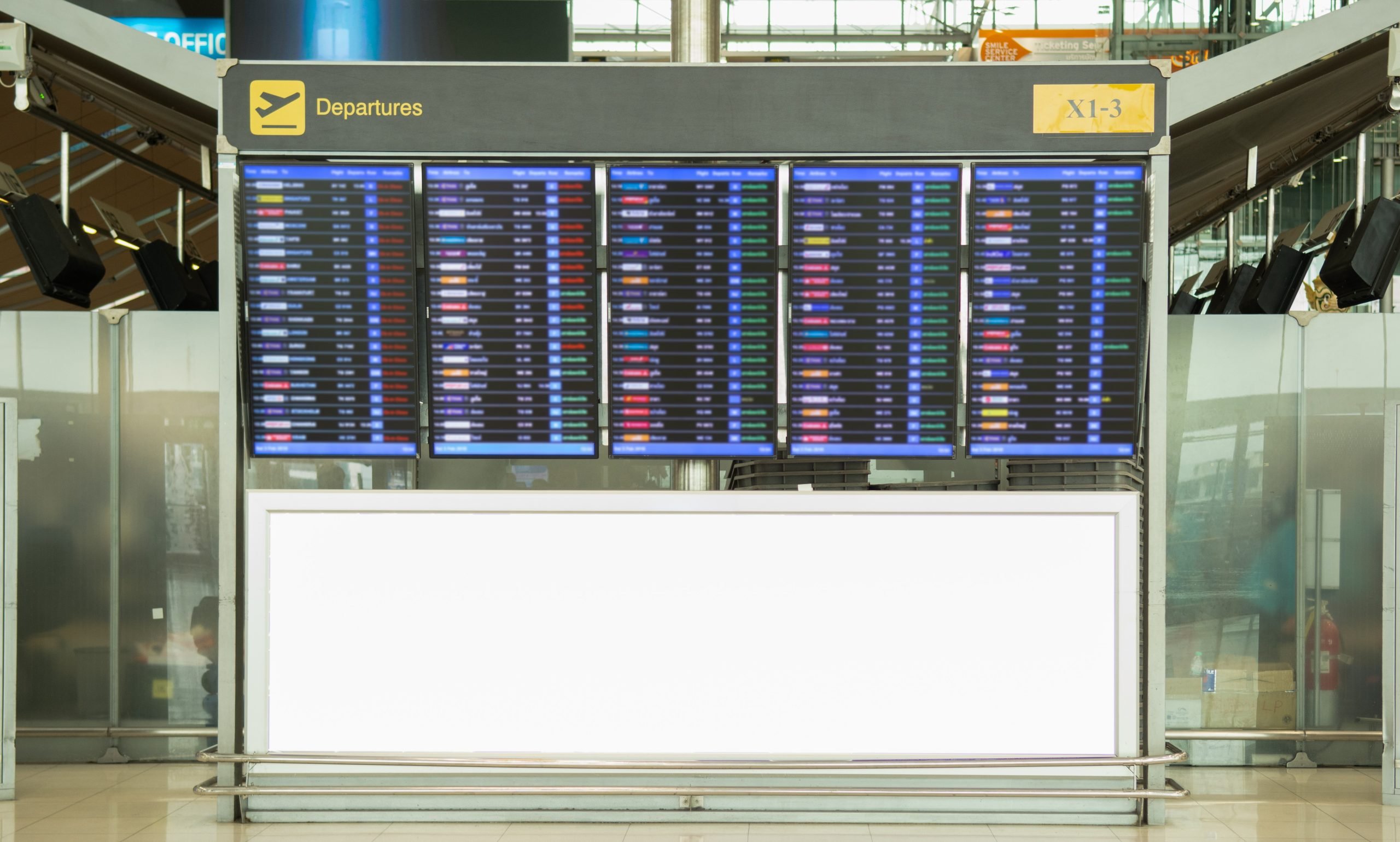
- Challenge: Confusing layouts and outdated signs leave travelers lost.
Solution: Airport wayfinding systems with interactive maps and real-time flight information guide passengers clearly, reducing stress. - Challenge: Flight changes or emergencies aren’t communicated quickly.
Solution: Flight information display systems (FIDS) and airport emergency displays deliver instant updates, keeping everyone informed. - Challenge: Balancing efficient operations with passenger satisfaction.
Solution: Digital airport communication systems streamline updates across terminals, saving staff time and boosting traveler trust.
Digital signage keeps passengers informed and relaxed & improves communication and wayfinding.

Key Applications and Use Cases
Digital signage in airports has emerged as a great help for commuters. Here are some of the use cases:
1. Flight Information Display Systems (FIDS)
FIDS are the heart of airport digital displays. Positioned in high-traffic areas, these screens show flight schedules, gate changes, and baggage claim details instantly. For example, Singapore Changi Airport’s FIDS is often praised for being clear and plentiful, letting travelers check updates without chasing down staff. These systems free up airport teams to focus on other tasks.
2. Wayfinding and Navigation
Getting lost in a massive terminal is no fun. Airport wayfinding systems make navigation simple with interactive kiosks and maps. Heathrow Airport’s digital maps display walking times to gates and nearby amenities like restaurants. These tools help travelers, especially those navigating unfamiliar airports, move with confidence.
3. Security and Emergency Communications
In a crisis, clear communication saves the day. Airport emergency displays broadcast urgent alerts, often in multiple languages with visuals or audio. Most people often comment on Dubai International Airport’s signage, which guides passengers calmly during emergencies, thereby enhancing safety and reducing confusion.
4. Commercial and Advertising Opportunities
Airport digital signage ROI comes alive through advertising. Screens in duty-free shops or lounges show targeted ads, like deals tailored to a traveler’s destination. A good example is Frankfurt Airport, which uses dynamic ads to capture attention and generate revenue. These displays can also promote local attractions, making layovers feel like a quick city tour.
Learn: How using digital signage at restaurants helps promote offers and improve guest satisfaction.
Impact and Advantages of Digital Signage on Airport
Digital signage in airports has a highly positive impact on the industry because of the benefits it carries. Here are some of the major advantages of digital signage in airports.
1. Enhanced Passenger Experience
Digital signage in airports transforms trips from chaotic to smooth. Real-time flight information on FIDS keeps passengers updated on delays or gate changes, easing anxiety. Interactive airport kiosks, like those at Vancouver International Airport, let travelers find coffee shops or book duty-free items. One traveler in a YouTube comment called these kiosks a “lifesaver” for turning a dull layover into a chance to explore airport amenities.
2. Operational Efficiency Improvements
Centralized systems allow staff to update airport digital displays instantly, reducing errors and saving time. You can see how Delta Airlines cut security wait times by 15% using smart signage. These smart airport technology solutions integrate with flight databases and security systems, keeping lines moving and operations humming.
3. Real Time Updates
Digital Signage allows you to update information visible on the screen, which makes it extremely helpful for places like airports, where last-minute updates are very common. Whether it is a change of gates for a flight or a delay in departure, everything can be updated at once via effective digital signage at airports.
4. Smooth Wayfinding
One major problem at airports that can be easily solved by placing digital signage is wayfinding. Finding the right gate for the flights can be a hassle for travellers, but with a screen constantly updating them with directions, it can be very convenient.
5. Retail Boost
Shops at the airport can enhance their visibility by displaying themselves on digital signage. With eye-catching visuals and important information about products and services, they can attract any passenger waiting for their flight. They can also use the signage to display people using their product or positive reviews posted by their existing customers to build trust. Tools like Social Walls can help them do the same with ease.
Explore: Creative ways to use Retail digital signage to attract and retain more customers.
Technology Trends and Innovation
Just like the world is evolving, technology in digital signage at airports has also been evolving. This shift is part of the broader digital transformation in aviation, which is revolutionizing how airports operate, communicate, and enhance passenger experience. Here are some of the technology trends and innovations.
1. Social Media Walls
Social media walls are vibrant screens displaying real-time posts from travelers, like an Instagram snap of a sleek airport lounge. Tools like Social Walls make it easier to collect and showcase social media content on screens. These walls can create a lively atmosphere in waiting areas, encouraging passengers to share their experiences online. It makes travelers feel connected, and with the airports’ story, they boost engagement.
2. Smart Integration and Connectivity
Smart airport technology solutions rely on seamless connections. IoT links signage to flight data, mobile apps, and baggage trackers. Sensors predict wait times and display them on screens, helping travelers decide whether to grab a snack or head to security. This integration keeps everyone on the same page.
3. Interactive and Touch-Free Solutions
Post-COVID, hygiene is a priority. Interactive airport kiosks now use gesture controls or voice commands. These AI-driven kiosks respond in multiple languages, making navigation easier for international travelers and earning praise in YouTube comments for accessibility.
4. Advanced Display Technologies
Holographic staff at London Luton or massive LED walls at Istanbul Airport? These advanced display technologies grab attention. One can guess how vibrant, high-definition displays ensure travelers notice critical updates while adding a modern, sleek vibe to terminals.
Checkout This: If You Want To Add Digital Signage to Your Lobby.
Implementation Best Practices
For digital signage in an airport to shine, it is important to follow best practices. Here are a few of them:
1. Strategic Placement and Design
Position airport digital displays in busy areas, such as check-in counters, gates, and baggage claim, for maximum impact. A Vantage Group YouTube video praised LaGuardia’s signage for showing walking times to gates, calling it a traveler’s dream. Clean designs with bold fonts, like those at Heathrow, reflect strategic design solutions that ensure readability for all.
2. Content Management and Updates
A centralized system for digital airport communication lets staff update screens instantly. One dashboard controls everything, keeping flight information and ads up to date. Regular updates prevent outdated info from confusing travelers.
3. Technical Infrastructure Requirements
Reliable Wi-Fi and durable hardware, like Faytech’s industrial touchscreens, are essential. A Future Travel Experience YouTube video emphasized that robust infrastructure prevents glitches, ensuring screens stay operational in busy environments. Moreover, a social media wall in airports can also keep travelers engaged. Social Walls is a prominent tool that makes this process simple and smooth.,
4. Technical Challenges
Cybersecurity is a concern; digital systems need strong encryption to avoid hacks. Compatibility with older airport systems can also slow implementation, requiring careful planning. Airports are also beginning to adopt identity security practices, such as protecting non-human identities (service accounts) that signage platforms rely on, to reduce the risk of breaches and prevent data leakage that could compromise both passenger information and operational integrity. As airports become smarter and more connected, keeping systems secure from anywhere is crucial. A remote access VPN lets authorized teams log in safely to monitor or update systems offsite without risking sensitive data. The real challenge is finding that balance between easy access and airtight security.
5. Operational Challenges
Staff training is key to avoiding outdated signage. A Wavetec YouTube video emphasized the importance of clear protocols for updates and maintenance to keep systems running smoothly, ensuring travelers receive accurate information every time.
Digital signage helps guide passengers clearly
and keeps them updated at airports.

Conclusion
Digital signage in airports is more than flashy tech; it’s a travel game-changer. From flight information display systems that deliver real-time flight information to airport wayfinding systems that guide passengers through terminals, this technology makes trips smoother. With airport digital signage ROI driving revenue and a huge number of passengers expected per day for the next few years, these systems are setting airports up for success. Next time a terminal feels overwhelming, those airport digital displays are working hard to guide travelers to their gates with ease and a smile.

